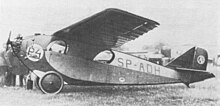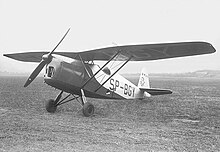RWD (aircraft manufacturer)

With the abbreviation RWD the planes of the three Polish designers will Stanislaw R ogalski , Stanislaw W igura and Jerzy D rzewiecki designated. The team became known in the 1930s for its light, high-decker touring aircraft , with which several FAI recognized records were flown.
history
The first design was the RWD-1 from 1928. With the second type RWD-2 on October 16, 1929, an altitude record of 4,004 meters was set for aircraft of this class and several competitions were won.
In 1931 the three designers moved to the workshops of the Technical University in Warsaw- Okęcie and continued their work there. The premises were later renamed Doświadczalne Warsztaty Lotnicze (DWL) (Warsaw Experimental Aircraft Factory). This is also where the RWD-6 was built, which won the Challenge de Tourisme International in 1932 . Stanisław Wigura had a fatal crash with this guy on September 11, 1932. The successor model RWD-9 took the first three places in 1934 and repeated this extraordinary achievement at the Circuit of Europe in the same year.
With a converted RWD-5 Stanisław Skarżyński succeeded on 7/8. May 1933 an internationally acclaimed South Atlantic crossing from St. Louis-de-Sénégal to Maceió .
Two better-known types were the RWD-8 trainer aircraft (almost 600 built) and the RWD-14 “Czapla”, a close-up reconnaissance aircraft for the Polish Air Force , of which 65 were built at the LWS plant. The aircraft construction at DWL ended with the invasion of the German troops in September 1939.
Constructions
- RWD-1: high-wing sport aircraft (1928), one copy built
- RWD-2 : high-wing sports aircraft (1929), four built
- RWD-3: Liaison aircraft based on the RWD-2, one copy built
- RWD-4: High-wing sport aircraft, developed from the RWD-2, ten pieces built
- RWD-5: High-wing sports aircraft (1931), twenty units built, a RWD-5bis (SP-AJU) flight to the South Pacific in May 1933
- RWD-6: high-wing sports aircraft (1932), three of which were built for the 1932 European tour
- RWD-7: Record aircraft (1931), developed from the RWD-2, a specimen built, set a speed record in its class on August 12, 1931 and an altitude record on September 30, 1932 (178.75 km / h resp. 6023 m)
- RWD-8 : High-wing trainer aircraft for the Polish Army (1932), RWD's greatest commercial success, built around 500 to 600, also under license from PWS
- RWD-9 : high-wing sport aircraft (1933), designed for the European sightseeing flight in 1934 , eight pieces built
- RWD-10 : high-wing aerobatic trainer aircraft (1933), 23 units built
- RWD-11 : low-wing, short-haul airliner for six passengers (1936), prototype only
- RWD-13 : High-wing sport aircraft, further development of the RWD-6 from 1935, 110 units built, including 15 RWD-13S medical aircraft
- RWD-14 : High-wing reconnaissance aircraft from 1935, 65 built by LWS
- RWD-15: high-decker touring aircraft for four passengers from 1937, 15 pieces ordered, but only four to five were built before the outbreak of war
- RWD-16 : high-wing sports aircraft (1936), series production planned as RWD-16bis, probably only a few built
- RWD-17 : aerobatic training aircraft (1937), few built until the outbreak of war
- RWD-18: twin-engine business aircraft with STOL characteristics, prototype destroyed in an air raid in 1939
- RWD-19: high-wing sport aircraft (1939), prototype only
- RWD-20: Experimental high-decker, RWD-9 prototype with nose wheel landing gear (1938)
- RWD-21: high-wing sports aircraft (1939), further development of the RWD-16, probably only a prototype
- RWD-22: Coastal reconnaissance aircraft / torpedo bomber for the Polish Navy, two prototypes launched, but not completed
- RWD-23: training aircraft (1939), prototype only
- RWD-25: low wing fighter from 1939, only project
source
Web links
Individual evidence
- ↑ Peter Alles-Fernandez (Ed.): Aircraft from A to Z. Volume 3: Koolhoven FK 56 - Zmaj. Bernard & Graefe, Koblenz 1989, ISBN = 3-7637-5906-9, pp. 254-257


